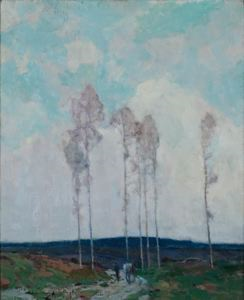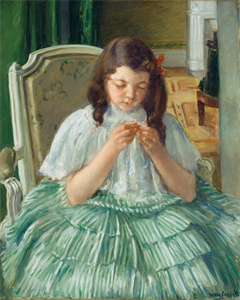Object Results
| Showing 1 of 1 |
|

Chauncey Foster Ryder
American, 1868–1949
As in previous generations, young American painters at the beginning of the twentieth century felt compelled to explore the European art scene as a vital component of their professional training. Their experiences were clearly discernable in their products long after they returned to America; the most important of the contemporary French painting movements at the end of the nineteenth century—the Barbizon School and French Impressionism—had a profound and long-lived impact on American painting until the middle of the twentieth century.
Among the most successful of the early twentieth-century artists influenced by French painting was Chauncey Foster Ryder, a painter/printmaker who was born in Danbury, Connecticut and grew up in New Haven. Ryder moved to Chicago in his twenties to pursue an art education, first at the School of the Art Institute, and later at Smith’s Academy. In 1901, he traveled to Paris, where he studied at the Académie Julian, and with the painters Jean Paul Laurens (1838–1921) and Raphael Colin (1850–1916). After two years he had his first painting accepted by the Paris Salon and he exhibited there regularly until 1909. As early as 1907, New York dealer William Macbeth, whose gallery was devoted to exhibiting the work of Americans, approached Ryder about marketing his work. Although Ryder was still living in Europe, Macbeth was impressed by the reception his paintings received in the Salons, and in 1910 he became Ryder’s dealer. Macbeth held solo exhibitions in 1910, 1921, 1923, 1927, and in 1930, and regularly included the artist in the gallery’s group exhibitions.
Macbeth had established his gallery in 1892, and it was there that the groundbreaking exhibition of works by Robert Henri (1865–1929) and his associates (later known as The Eight) was held in 1908. In the long term, however, Macbeth was content to promote artists working in traditional European-derived styles rather than those pursuing modernism, and he established Ryder’s reputation for landscape paintings conceived in a style that was conservative, distinct and thus marketable. Ryder was fortunate in his choice of William Macbeth as his dealer; their business partnership allowed the artist to establish a studio and home in Wilton, New Hampshire where he lived most of the remainder of his life.
Like the Barbizon artists, Ryder attempted to convey a sense of the moods of nature in his paintings, which were animated by the characteristically loose brushwork of the Impressionists. He was “attracted to the poetic aspect of nature rather than the literal semblance of a specific scene.” His designs are pared down to basic forms, lacking significant detail, but they preserve the verdant atmosphere of the New England valleys and pastures that became his most frequent subjects.
Waning Day is typical of Ryder’s paintings, with its focus on the palpable sense of atmosphere and light. The work is representative of what is known today as American Tonalism, that is, work favoring a harmony of subdued, modulated color designed to express emotion and mood rather than the reality of appearance. Waning Day was exhibited in Macbeth’s first exhibition of Ryder’s work in 1910, and the subject was probably rural New York State, where he traveled during the late spring and summer after his return from Europe to gather images that he refined later at his 57th Street studio in Manhattan.
Pisano, Ronald. “Chauncey Foster Ryder: Peace and Plenty,” American Art and Antiques, September-October, 1978, pp. 76¬–83.
Gerdts, William. Art Across America: Two Centuries of Regional Painting, 1710-1920. New York: Abbeville Press, Publishers, 1990, Volume One, p. 128; Volume Three, pp. 149, 152, 306.
Sessions, Ralph, et al. The Poetic Vision: American Tonalism. New York: Spanierman Gallery, LLC, 2005, pp. 164–5.
American, 1868–1949
Waning Day
1910
Object Type:
Painting
Dimensions:
30 x 25 1/4 in. (76.2 x 64.14 cm)
Medium and Support:
Oil on canvas
Accession Number:
2018.0010.0009
Credit Line:
Gift of Babette L. Wampold in memory of Charles H. Wampold
Currently On View
As in previous generations, young American painters at the beginning of the twentieth century felt compelled to explore the European art scene as a vital component of their professional training. Their experiences were clearly discernable in their products long after they returned to America; the most important of the contemporary French painting movements at the end of the nineteenth century—the Barbizon School and French Impressionism—had a profound and long-lived impact on American painting until the middle of the twentieth century.
Among the most successful of the early twentieth-century artists influenced by French painting was Chauncey Foster Ryder, a painter/printmaker who was born in Danbury, Connecticut and grew up in New Haven. Ryder moved to Chicago in his twenties to pursue an art education, first at the School of the Art Institute, and later at Smith’s Academy. In 1901, he traveled to Paris, where he studied at the Académie Julian, and with the painters Jean Paul Laurens (1838–1921) and Raphael Colin (1850–1916). After two years he had his first painting accepted by the Paris Salon and he exhibited there regularly until 1909. As early as 1907, New York dealer William Macbeth, whose gallery was devoted to exhibiting the work of Americans, approached Ryder about marketing his work. Although Ryder was still living in Europe, Macbeth was impressed by the reception his paintings received in the Salons, and in 1910 he became Ryder’s dealer. Macbeth held solo exhibitions in 1910, 1921, 1923, 1927, and in 1930, and regularly included the artist in the gallery’s group exhibitions.
Macbeth had established his gallery in 1892, and it was there that the groundbreaking exhibition of works by Robert Henri (1865–1929) and his associates (later known as The Eight) was held in 1908. In the long term, however, Macbeth was content to promote artists working in traditional European-derived styles rather than those pursuing modernism, and he established Ryder’s reputation for landscape paintings conceived in a style that was conservative, distinct and thus marketable. Ryder was fortunate in his choice of William Macbeth as his dealer; their business partnership allowed the artist to establish a studio and home in Wilton, New Hampshire where he lived most of the remainder of his life.
Like the Barbizon artists, Ryder attempted to convey a sense of the moods of nature in his paintings, which were animated by the characteristically loose brushwork of the Impressionists. He was “attracted to the poetic aspect of nature rather than the literal semblance of a specific scene.” His designs are pared down to basic forms, lacking significant detail, but they preserve the verdant atmosphere of the New England valleys and pastures that became his most frequent subjects.
Waning Day is typical of Ryder’s paintings, with its focus on the palpable sense of atmosphere and light. The work is representative of what is known today as American Tonalism, that is, work favoring a harmony of subdued, modulated color designed to express emotion and mood rather than the reality of appearance. Waning Day was exhibited in Macbeth’s first exhibition of Ryder’s work in 1910, and the subject was probably rural New York State, where he traveled during the late spring and summer after his return from Europe to gather images that he refined later at his 57th Street studio in Manhattan.
Pisano, Ronald. “Chauncey Foster Ryder: Peace and Plenty,” American Art and Antiques, September-October, 1978, pp. 76¬–83.
Gerdts, William. Art Across America: Two Centuries of Regional Painting, 1710-1920. New York: Abbeville Press, Publishers, 1990, Volume One, p. 128; Volume Three, pp. 149, 152, 306.
Sessions, Ralph, et al. The Poetic Vision: American Tonalism. New York: Spanierman Gallery, LLC, 2005, pp. 164–5.
Portfolio List
Click a portfolio name to view all the objects in that portfolio
This object is a member of the following portfolios:
Your current search criteria is: All Object records and [Object]Display Artist is "Chauncey Foster Ryder".
